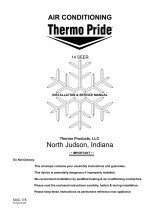
Form I-COND (01-12-18), P/N 220746R9, Page 2
Table of Contents
1.0 General ..........................3
1.1 Hazard Labels and Notices ............3
1.2 General Information ..................4
1.3 Warranty ..........................4
1.4 Installation Codes ....................4
2.0 Location .........................5
3.0 Receiving, Moving, and Uncrating ....5
3.1 Receiving ..........................5
3.2 Moving ............................5
3.3 Uncrating ..........................5
3.3.1 Shipped-Separate Items ...........5
4.0 Clearances and Dimensions .........5
4.1 Clearances .........................5
4.2 Dimensions .........................6
5.0 Mounting .........................7
5.1 Weights............................7
5.2 Lifting .............................7
5.3 Mounting ..........................7
6.0 Mechanical .......................7
6.1 Refrigerant Piping ....................7
6.1.1 Location of Piping Connections at
the Condensing Unit ..............7
6.1.2 Location of Piping Connections at
the Split System Evaporator Coil.....8
6.1.3 Refrigerant Piping Guidelines
(R-410A Refrigerant) ............11
6.1.3.1 Type of Refrigerant Piping .....11
6.1.3.2 Refrigerant Piping Length
and Size ......................11
6.1.3.3 Liquid Line Piping ............13
6.1.3.4 Suction Line ................15
6.1.3.5 Optional Hot Gas Bypass Lines .15
6.1.3.6 Brazing Connections .........16
6.1.3.7 Piping Support and Insulation ...16
6.2 Leak Test the Refrigerant Circuits.......16
6.2.1 Leak Test the Condensing Unit ....16
6.2.2 Leak Test the Field-Installed Piping..17
6.3 Evacuate the Circuits ................17
6.4 Charge with R-410A Refrigerant .......17
7.0 Electrical and Wiring ..............18
7.1 General ...........................18
7.1.1 Wiring Diagram . . . . . . . . . . . . . . . . .18
7.2 Supply Wiring ......................18
7.2.1 Disconnect Switch...............18
7.2.2 Supply Voltage .................18
7.3 Unit Wiring Requirements ............19
7.4 Control Wiring ......................21
8.0 Controls and Operation ............21
8.1 Analog Control System ...............21
8.2 Digital Control System ...............21
8.3 Other Compressor and Refrigerant
Controls .........................22
8.3.1 High Pressure Cutoff .............22
8.3.2 Low Pressure Cutoff .............22
8.3.3 Hot Gas Bypass Valve (Option
CUG2 or CUG3) ................22
8.3.4 Compressor Protection (CUB1).....22
8.3.5 Crankcase Heaters ..............22
9.0 Final Checks and Start-Up..........23
9.1 General Comments ..................23
9.1.1 Checklist Prior to Start-up .........23
9.2 Start-up ...........................24
9.2.1 Power Supply Voltage Phasing .....24
9.2.2 Operating Sequence .............24
9.2.3 Refrigerant Charge ..............25
9.2.3.1 Check SUBCOOLING ........25
9.2.3.2 Determine SUPERHEAT .......25
9.2.4 Optional Hot Gas Bypass Valve ....26
10.0 Maintenance and Service..........26
10.1 General ..........................26
10.2 Maintenance Schedule ..............27
10.3 Condenser Fan(s) Maintenance .......27
10.4 Condenser Coil Maintenance .........28
10.5 Compressor Maintenance and
Replacement .....................28
10.6 Troubleshooting Chart...............34
APPENDIX
IMPORTANT Reminders about R-410A
Refrigerant and POE Oil ............36
Model MASA Technical Information ........36
Electrical Information....................37
Pressure/Temperature Chart for R-410A
Refrigerant for Checking Subcooling
and Superheat ....................37
CONDENSER STARTUP FORM ..........38
INDEX ..........................39
INSTALLATION RECORD - to be
completed by the installer .........40

























